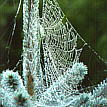
It is five times as strong as steel, twice as elastic as polyamide fibres (it can be stretched by 31% without breaking), more elastic than aramid fibre, finer than a human hair, and lighter than cotton.
Spider silk has been used ever since. Promises are: bulletproof vests, parachute cords, bridge suspension cables, wear-resistant shoes and clothing, seat belts, rustfree bumpers for automobiles, artificial tendons and ligaments, etc..
Danish Name
Category
Products
Processes
Cloned bacteria spinning
Similar materials
Aramid fibres (kevlar)
References
Cornell Biotechnology Center
Artificial spider silk
Environmen- tal notes
Use: It is an environment-friendly biopolymer.
Disposal: Easy to recycle.
Additional Info
When synthesis of spider silk in bacteria or plants becomes efficent, spider silk will have a commercial relevance.
Photo
Copyright
This page is part of Design inSite
Disclaimer